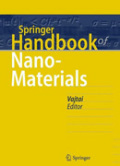
The Springer Handbook of Nanomaterials covers the description of materials which have dimension on the 'nanoscale'. The description of the nanomaterials inthis Handbook follows the thorough but concise explanation of the synergy of structure, properties, processing and applications of the given material. The Handbook mainly describes materials in their solid phase; exceptions might be e.g. small sized liquid aerosols or gas bubbles in liquids. The materials are organized by their dimensionality. Zero dimensional structures collect clusters, nanoparticles and quantum dots, one dimensional are nanowires and nanotubes, while two dimensional are represented by thin films and surfaces. The chapters in these larger topics are written on a specific materials and dimensionality combination, e.g. ceramic nanowires. Chapters are authored by well-established and well-known scientists of the particular field. They have measurable part of publications and an important role in establishing new knowledge of the particular field. Meets the need for a comprehensive, easily accessible source of application-oriented, authoritative information by integrating knowledge from key subfields. Highly detailed single-volume treatment of a rapidly evolving field. INDICE: Foreword by Neal Lane. Part A NanoCarbons. Part B Nano Metals. Part C Nano Ceramics. Part D NanoSemiconductors. Part E Nanocomposites and Solutions. Part F Nanoporous Materials. Part G Organic and Bio Nanomaterials. Part HApplications and Impact. Acknowledgements. About the Authors.- Subject Index.
- ISBN: 978-3-642-20594-1
- Editorial: Springer Berlin Heidelberg
- Encuadernacion: Cartoné
- Páginas: 1500
- Fecha Publicación: 01/08/2012
- Nº Volúmenes: 1
- Idioma: Inglés
